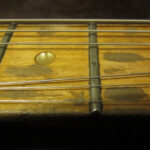Acoustic guitars are a fantastic starting point for anyone eager to learn music. Their rich, resonant sound is produced naturally, making them engaging instruments to play and hear. But how exactly do these instruments create their sound, and what kinds are best for beginners? Let’s dive into the basics of Beginner Acoustic Guitars.
How Acoustic Guitars Produce Sound
Unlike electric guitars that rely on amplifiers, acoustic guitars use their physical structure to amplify the sound of vibrating strings. The key component is the soundboard, typically the guitar’s top. When you pluck or strum a string, its vibrations are transferred through the bridge to the soundboard.
Think of the soundboard as a speaker. It’s a large, thin piece of wood designed to vibrate efficiently. As the soundboard vibrates, it moves the air around it, creating sound waves that we hear. Different types of wood (tonewoods) and internal bracing patterns of the soundboard contribute to the unique tonal qualities and loudness of each guitar.
The hollow body of an acoustic guitar is also crucial. It acts as a resonating chamber, amplifying and enriching the sound, especially in the lower frequencies, giving acoustic guitars their full, warm tone. Without this resonating body and soundboard, guitar strings alone would produce a very faint sound. The complex interaction of these elements creates the distinctive and beautiful sound of an acoustic guitar.
Types of Acoustic Guitars for Beginners
When you’re starting your guitar journey, understanding the main types of acoustic guitars can help you choose the right instrument. The two primary types are steel-string acoustic guitars and classical guitars.
Steel-string Acoustic Guitars
Steel-string guitars are the most common type of acoustic guitar you’ll see in popular music genres like folk, rock, country, and pop. They are known for their bright and powerful sound, thanks to the steel strings which create more tension and vibration.
A popular and versatile body shape, especially for beginners, is the dreadnought. This shape, popularized by Martin guitars, offers a balanced tone and ample volume, making it suitable for various playing styles. While other shapes like jumbo, auditorium, and grand concert exist, the dreadnought provides a good starting point due to its comfortable size and sound projection. For beginners seeking a slightly smaller and comfortable option, consider guitars with an auditorium or concert body shape.
Steel-string guitars are typically played with a pick and are excellent for strumming chords and playing lead lines. Their brighter sound is well-suited for contemporary music styles, making them a popular choice for beginners eager to play along with their favorite songs.
Classical Guitars
Classical guitars are another significant type of acoustic guitar, distinguished by their nylon strings. These strings are softer and wider than steel strings, making them gentler on the fingertips, which is a significant advantage for beginners.
Classical guitars produce a warmer, mellower, and more delicate tone compared to steel-string guitars. They are traditionally used for classical, flamenco, and fingerstyle guitar music. The wider neck and flat fretboard are designed for fingerstyle playing, where individual strings are plucked with the fingers rather than strummed with a pick.
For beginners interested in classical music or fingerpicking styles, a classical guitar is an excellent choice. The nylon strings are easier on the fingers initially, allowing beginners to practice for longer periods without discomfort.
Conclusion
Understanding how acoustic guitars work and the different types available is the first step in your musical journey. Whether you choose a steel-string for its bright sound and versatility or a classical guitar for its gentle strings and warm tone, the world of acoustic guitar offers a rewarding experience for beginners. Explore both types, consider your musical preferences, and choose the beginner acoustic guitar that inspires you to start playing!


